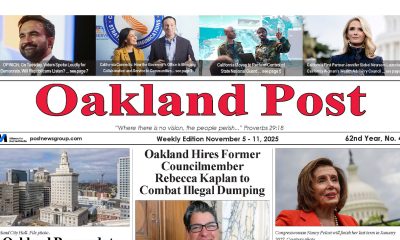Featured
Oakland Mayoral Candidates Address Black Issues
The contest to become the next mayor of Oakland began to get more serious this week, as 10 candidates for the job faced some tough questions at the 100 Black Men of the Bay Area’s mayoral debate.
< p> Speaking at a packed meeting in Oakland City Hall chambers Wednesday evening, the candidates answered questions from representatives of African American organizations.
An immediate challenge confronting the candidates is to distinguish themselves from each other and from incumbent Jean Quan, who is standing on what she considers to be her accomplishments – creating affording housing, reducing violent crime and bringing economic development to the city.
City Auditor Courtney Ruby was asked a question about what she would do as mayor if there were a recurrence of a situation where Oakland’s Workforce Investment Board (WIB) administrators failed to utilize funds and therefore had to send back $650,000 to the state for job training for unemployed Oaklanders.
“This is absolutely unacceptable in our community – we need to be able to track every dollar that’s coming in,” said Ruby, who at the time did not use her elected position to investigate why the city lost the money.
“The Workforce Investment Board is a total travesty in my opinion,” said civil rights attorney Dan Siegel. “It sucks up too much of the job funds. The administration should be cut,” he said adding that anyone who gives back funds should be fired.
“It’s atrocious, but its goes beyond that. Oakland needs to get some skin in the game,” said Councilmember Libby Schaaf, pointing out that Oakland uses a significant part of its federal Workforce Investment Act funding for overhead rather than kicking in additional money for on-the-ground services.
The panel of questioners included Kimberley Mayfield Lynch of the Oakland Berkeley Chapter of Black Women Organized for Political Action (BWOPA), Merlin Edwards of the Oakland African American Chamber of Commerce, Diane Lewis of 100 Black Women, Pastor Gerald Agee of Pastors of Oakland and Paul Cobb publisher of the Post and El Mundo newspapers.
Civil rights attorney John Burris moderated the debate and asked some questions. Leaders of 100 Black Men of the Bay Area Frank Tucker and Derrick Bulls hosted the forum.
Celebrating the huge Oakland Army Base development that broke ground under her administration, Mayor Quan said, the project is reaching the city’s 50 percent local hiring goal. But finding people to fill these jobs is tough, she said, adding that she has to do outreach to churches to recruit workers.
However, according to the West Oakland Job Resource Center, there is a waiting list of construction workers seeking employment at the Army Base project.
Post publisher Cobb chimed in, saying that Quan was reluctant to advertise her message in the Black and Brown media. All the other candidates then said if they were mayor they would heartily advertise in the Black press to reach the voters who attend the city’s more than 500 Black houses of worship.
With the new development coming into the city, “we have to be sure people are not left behind,” said Quan, citing figures that place unemployment of 18-25 year olds at 35 percent in East Oakland and only 4 percent in Montclair.
Addressing the hot button issue of public safety, the candidates pledged to contribute resources to reduce recidivism and help unemployed and out-of-school youth.
Several candidates pledged to dramatically increase the number of police officers to 800 or more, though they did not say how they would pay for them.
Oakland had 654 sworn police officers as of the beginning of May, and public safety already consumes about 50 percent of the city’s annual budget. Potential new officers are currently attending a Police Academy at a cost of about $4 million.
“The minimum is 900 (officers),” said candidate Joe Tuman,
Bearing down on public safety, Port Commissioner Bryan Parker asked, “Do you feel safer than you did four years ago? People do not feel safe at home, at work and walking round in the streets. “
“We need a safe, educated, economically healthy Oakland,” he said.
Ruby ended her remarks with a call to action. “Imagine what we could do if we had City Hall on our side.”
Quan emphasized the progress that OPD has made during her administration. “Our police force is the most diverse (it has been) and more effective than it has been in more than a decade,” she said.
Candidates also opposed gentrification, comparing Oakland’s potential future to the negative example of the forcing out of African American and Latino residents of San Francisco.
The people who are forced to move out, said Tuman, are the most vulnerable residents with limited “social and economic capital.”
Siegel said he would work with organizations like Urban Strategies Council to use up to 1,200 acres of existing public land to build affordable housing for 5,000 Oakland residents. He also was interrupted with applause when he said he would help establish a minimum wage of $15 an hour and create an Oakland Bank to help with housing affordability issues.
The answer, said Parker, is training and better paying jobs for Oakland residents.
Other candidates who spoke at the forum were Jason Anderson, endorsed by the Green Party; Patrick McCullough; Sam Washington, business and technology solutions strategist; and Larry Lionel Young Jr., past candidate for City Council, District 3, and for mayor in 2010.
Anderson was warmly received over his plans on how to purchase and preserve historic housing in the Black community, such as the Marcus Garvey Building
Publisher Cobb said, “Based upon the candidates’ answers at this debate, I’d estimate that the attendees’ ranked choices would be Siegel, Parker and Schaaf. But Anderson is coming on strong.”
Alameda County
Seth Curry Makes Impressive Debut with the Golden State Warriors
Seth looked comfortable in his new uniform, seamlessly fitting into the Warriors’ offensive and defensive system. He finished the night with an impressive 14 points, becoming one of the team’s top scorers for the game. Seth’s points came in a variety of ways – floaters, spot-up three-pointers, mid-range jumpers, and a handful of aggressive drives that kept the Oklahoma City Thunder defense on its heels.

By Y’Anad Burrell
Tuesday night was anything but ordinary for fans in San Francisco as Seth Curry made his highly anticipated debut as a new member of the Golden State Warriors. Seth didn’t disappoint, delivering a performance that not only showcased his scoring ability but also demonstrated his added value to the team.
At 35, the 12-year NBA veteran on Monday signed a contract to play with the Warriors for the rest of the season.
Seth looked comfortable in his new uniform, seamlessly fitting into the Warriors’ offensive and defensive system. He finished the night with an impressive 14 points, becoming one of the team’s top scorers for the game. Seth’s points came in a variety of ways – floaters, spot-up three-pointers, mid-range jumpers, and a handful of aggressive drives that kept the Oklahoma City Thunder defense on its heels.
One of the most memorable moments of the evening came before Seth even scored his first points. As he checked into the game, the Chase Center erupted into applause, with fans rising to their feet to give the newest Warrior a standing ovation.
The crowd’s reaction was a testament not only to Seth’s reputation as a sharpshooter but also to the excitement he brings to the Warriors. It was clear that fans quickly embraced Seth as one of their own, eager to see what he could bring to the team’s championship aspirations.
Warriors’ superstar Steph Curry – Seth’s brother – did not play due to an injury. One could only imagine what it would be like if the Curry brothers were on the court together. Magic in the making.
Seth’s debut proved to be a turning point for the Warriors. Not only did he contribute on the scoreboard, but he also brought a sense of confidence and composure to the floor.
While their loss last night, OKC 124 – GSW 112, Seth’s impact was a game-changer and there’s more yet to come. Beyond statistics, it was clear that Seth’s presence elevated the team’s performance, giving the Warriors a new force as they look to make a deep playoff run.
#NNPA BlackPress
LIHEAP Funds Released After Weeks of Delay as States and the District Rush to Protect Households from the Cold
BLACKPRESSUSA NEWSWIRE — The federal government has released $3.6 billion in home heating assistance after a delay that left states preparing for the start of winter without the program’s annual funding.

By Stacy M. Brown
Black Press USA Senior National Correspondent
The federal government has released $3.6 billion in home heating assistance after a delay that left states preparing for the start of winter without the program’s annual funding. The Low-Income Home Energy Assistance Program, known as LIHEAP, helps eligible households pay heating and cooling bills. The release follows a shutdown that stretched 43 days and pushed agencies across the country to warn families of possible disruptions.
State officials in Minnesota, Kansas, New York, and Pennsylvania had already issued alerts that the delay could slow the processing of applications or force families to wait until December for help. In Pennsylvania, more than 300,000 households depend on the program each year. Minnesota officials noted that older adults, young children, and people with disabilities face the highest risk as temperatures fall.
The delay also raised concerns among advocates who track household debt tied to rising utility costs. National Energy Assistance Directors Association Executive Director Mark Wolfe said the funds were “essential and long overdue” and added that high arrearages and increased energy prices have strained families seeking help.
Some states faced additional pressure when other services were affected by the shutdown. According to data reviewed by national energy advocates, roughly 68 percent of LIHEAP households also receive nutrition assistance, and the freeze in multiple programs increased the financial burden on low-income residents. Wolfe said families were placed in “an even more precarious situation than usual” as the shutdown stretched into November.
In Maryland, lawmakers urged the Trump administration to release funds after the state recorded its first cold-related death of the season. The Maryland Department of Health reported that a man in his 30s was found outdoors in Frederick County when temperatures dropped. Last winter, the state documented 75 cold-related deaths, the highest number in five years. Rep Kweisi Mfume joined more than 100 House members calling for immediate federal action and said LIHEAP “is not a luxury” for the 100,000 Maryland households that rely on it. He added that seniors and veterans would be placed at risk if the program remained stalled.
Maryland Gov. Wes Moore used $10.1 million in state funds to keep benefits moving, but noted that states cannot routinely replace federal dollars. His administration said families that rely on medical equipment requiring electricity are particularly vulnerable.
The District of Columbia has already mapped out its FY26 LIHEAP structure in documents filed with the federal government. The District’s plan shows that heating assistance, cooling assistance, weatherization, and year-round crisis assistance operate from October 1 through September 30. The District allocates 50 percent of its LIHEAP funds to heating assistance, 10 percent to cooling, 13 percent to year-round crisis assistance, 15 percent to weatherization, and 10 percent to administrative costs. Two percent is used for services that help residents reduce energy needs, including education on reading utility bills and identifying energy waste.
The District’s plan lists a minimum LIHEAP benefit of $200 and a maximum of $1,800 for both heating and cooling assistance. Crisis benefits are provided separately and may reach up to $500 when needed to resolve an emergency. The plan states that a household is considered in crisis if it has been disconnected from energy service, if heating oil is at 5 percent or less of capacity, or if the household has at least $200 owed after the regular benefit is applied.
The District’s filing notes that LIHEAP staff conduct outreach through community meetings, senior housing sites, Advisory Neighborhood Commissions, social media, posters, and mass mailings. The plan confirms that LIHEAP applicants can apply in person, by mail, by email, or through a mobile-friendly online application and that physically disabled residents may request in-home visits.
As agencies nationwide begin distributing the newly released funds, states continue working through large volumes of applications. Wolfe said LIHEAP administrators “have been notified that the award letters have gone out and the states can begin to draw down the funds.”
#NNPA BlackPress
Seven Steps to Help Your Child Build Meaningful Connections
BLACKPRESSUSA NEWSWIRE — Swinging side by side with a friend on the playground. Sharing chalk over bright, colorful sidewalk drawings. Hiding behind a tree during a spirited game of hide-and-seek. These simple moments between children may seem small, but they matter more than we think

By Niyoka McCoy, Ed.D., Chief Learning Officer, Stride/K12
Swinging side by side with a friend on the playground. Sharing chalk over bright, colorful sidewalk drawings. Hiding behind a tree during a spirited game of hide-and-seek. These simple moments between children may seem small, but they matter more than we think: They lay the foundation for some of life’s most important skills.
Through everyday play, young children begin learning essential social and emotional skills like sharing, resolving conflicts, showing empathy, and managing their emotions. These social skills help shape emotional growth and set kids up for long-term success. Socialization in early childhood isn’t just a “nice-to-have”—it’s essential for development.
Yet today, many young children who haven’t yet started school aren’t getting enough consistent, meaningful interaction with peers. Research shows that there’s a decline in active free play and peer socialization when compared to previous generations.
There are many reasons for this. Children who are home with a parent during the day may spend most of their time with adults, limiting opportunities for peer play. Those in daycare or preschool may have restricted free play, and large classrooms can reduce supervision and social coaching. Some children live in rural areas, are homebound due to illness, have full schedules, or rely on screens to fill their playtime. And for some families, finding other families with young children to connect with isn’t easy.
While these challenges can feel significant, opportunities for connection still exist in every community. Families can take simple steps to help children build friendships, create a sense of belonging, and strengthen social skills. Here are some ideas to get started:
- Storytime sessions at libraries or local bookstores
- Community offerings such as parent-child workshops, art, music, gymnastics, swimming, or sports programs
- Weekly events at children’s museums, which may include art projects, music workshops, or science experiments
- Outdoor exploration, where kids can play with peers
- Local parenting groups that organize playdates and group activities
- Volunteer opportunities where children can participate, such as pet adoption events or packing meals at a food bank
- Classes for kids at local businesses, including hardware, grocery, or craft stores
Some of these community activities are free or low-cost and give kids the chance to build friendships and practice social skills. Parents can also model positive social behavior by interacting with other parents and encouraging their children to play with their peers.
These may seem like small moments of connection, but they can have a powerful impact. Every time your child shares a toy, plays make-believe with peers, or races a friend down the slide, they’re not just playing—they’re learning the skills that build confidence, empathy, and lasting friendships. And it’s good for you, too. Creating intentional opportunities for play also helps you strengthen your own network of parents who can support one another as your children grow together.
-

 Activism3 weeks ago
Activism3 weeks agoOakland Post: Week of November 12 – 18, 2025
-

 Activism4 weeks ago
Activism4 weeks agoOakland Post: Week of November 5 – 11, 2025
-

 Activism2 weeks ago
Activism2 weeks agoIN MEMORIAM: William ‘Bill’ Patterson, 94
-

 Activism3 weeks ago
Activism3 weeks agoHow Charles R. Drew University Navigated More Than $20 Million in Fed Cuts – Still Prioritizing Students and Community Health
-

 #NNPA BlackPress3 weeks ago
#NNPA BlackPress3 weeks agoThe Perfumed Hand of Hypocrisy: Trump Hosted Former Terror Suspect While America Condemns a Muslim Mayor
-

 Bay Area3 weeks ago
Bay Area3 weeks agoNo Justice in the Justice System
-

 #NNPA BlackPress3 weeks ago
#NNPA BlackPress3 weeks agoProtecting Pedophiles: The GOP’s Warped Crusade Against Its Own Lies
-

 #NNPA BlackPress2 weeks ago
#NNPA BlackPress2 weeks agoTrump’s Death Threat Rhetoric Sends Nation into Crisis























































